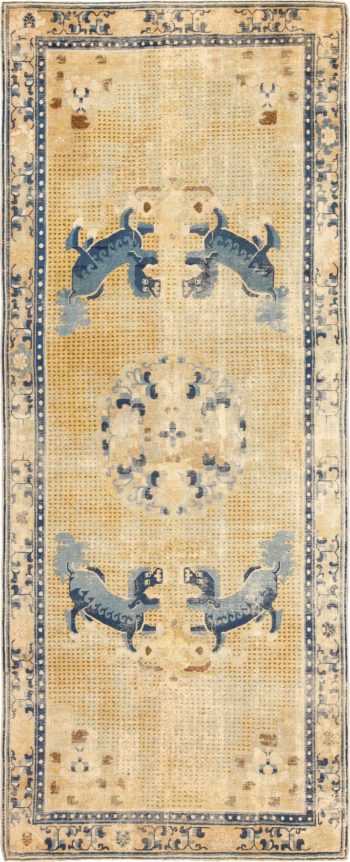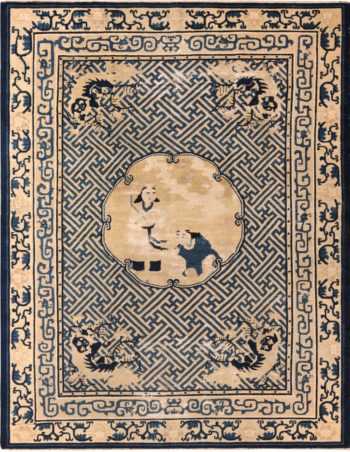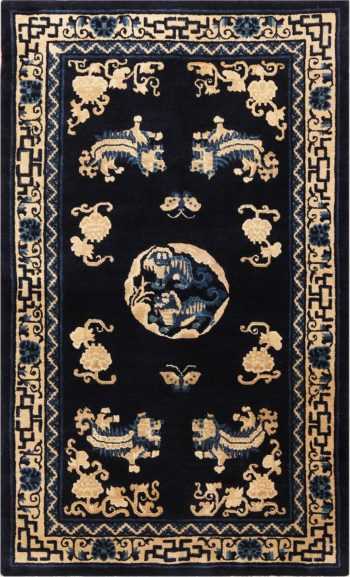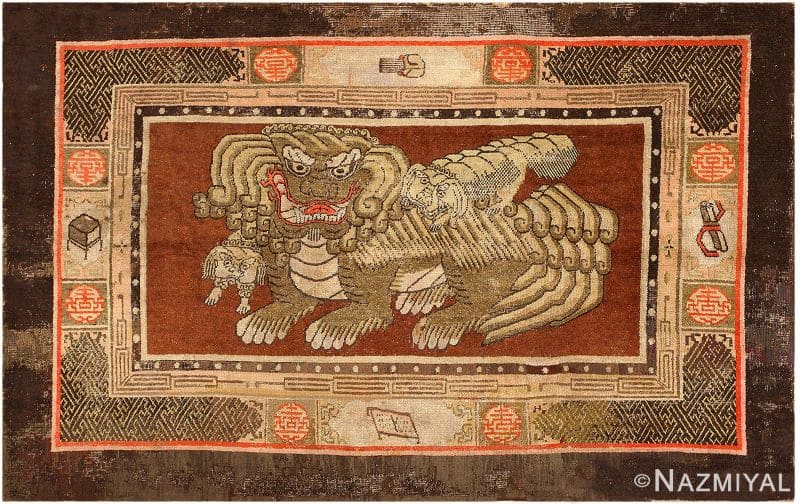Chinese Foo Dog Rugs
View Our Collection Of Chinese Foo Dog Design Rugs
-
Antique 18th Century Chinese Ningxia Chinese Foo Dog Design Rug 48886
$26,000.00Size: 6 ft 4 in x 15 ft 2 in (1.93 m x 4.62 m) -
Pictorial Antique Chinese Foo Dog Area Rug 71791
$12,500.00Size: 6 ft x 7 ft 4 in (1.83 m x 2.24 m) -
Small Antique Peking Foo Dog Chinese Rug 70039
$6,900.00Size: 4 ft 1 in x 6 ft 6 in (1.24 m x 1.98 m)
All About the Chinese Lions, aka Foo Dog
Chinese guardian lions, commonly called stone lions in China and sometimes called a foo dog in the West, are symbolic sculptures of the Asiatic lion. They are placed at the entrance of an important building to guard the grounds and the people within. They have been part of the history of China and southeast Asia for thousands of years. As with much of Asian culture, these ancient guardian lions are complex and multifaceted expressions of symbolic Chinese traditions.
Intro to the Foo Dog
Traditionally, stone lions are massive sculptures mounted on ornamental architectural base carvings called xumizuo. Based on the Asiatic lion rather than the African lion more familiar to the West, the stone lion is very different than depictions of lions seen in Europe. They are shown with bulging eyes, curly fur and mischievous smiles, often with wide-open roaring mouths to present a fierce appearance, the better to drive off unwanted spirits.
Guardian lions come in pairs, both male and female, providing balance and harmony. Occasionally the pair is depicted with a large pearl in the mouth of each lion to represent the sacred breath. The term “stone lion” is both a name and a generic descriptive term, with most being carved out of stone or marble, but many being cast in bronze. The lions simultaneously serve as a symbol of protection and an intimidating display of wealth and power.
Stone lions belong at the entrance to traditional architecture like Buddhist temples (the oldest use for such lions), important government buildings, and sometimes at mausoleums and tombs. The are also seen guarding the homes of elite citizens like generals, heroes, scholars, chi masters and the wealthy.
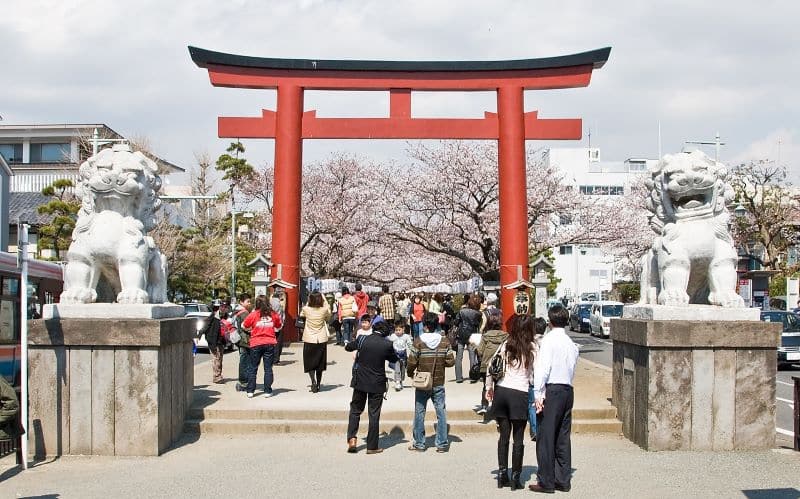
Foo dogs guarding an entrance.
Foo Dog Terminology
The most common term for the lions in China is shi, meaning lion, or shishi (pronounced she-see) for “stone lion.” Some anthropologists believe the word shi is descended from ser, a Persian word for the Asiatic lion. Guardian lions are also frequently referred to according to their sculpture media or their place in Chinese lore.
* Shishi: The term for a stone statue.
* Tongshi: The name for a bronze lion.
* Foshi: The Lion of Buddha, with the word “Fo” relating closely to Buddha himself.
* Ruishi: The Auspicious lion, a nickname for the Tibetan snow leopard.
The Japanese name for the lions is komainu. It’s common in the West for Europeans and Americans to call the stone lions “Fu Dogs” or “Foo Dogs.” Some people refer to them as Fo Lions. The Chinese word “Fo” relates to Buddha and the word “Fu” means “prosperity.”
In China it’s well understood that the sculptures are lions and they are never called dogs there. There is some speculation that Europeans and other westerners call the statues dogs because certain Chinese dog breeds like Chow Chows and Pekingese have a similar appearance to the guardian lions.

An Israeli carpet with Foo Dog imagery. (sold)
Mythological Tradition of the Foo Dog
The lion is one of the divine beasts of Chinese mythology, with the ability to drive off evil spirits. According to Chinese lore, stone lions are able to cleanse shar chi, or “poison arrows,” the negative force emanating from sharp corners, sickness, imposed authority, busy crowds and jarring structures such as lamp posts, obelisks and traffic lights.
This ability to drive away negative spirits and energy explains the original placement of these statues at the entrance to Buddhist temples. From there the practice spread to palaces, important residences and mausoleums. Guardian lions are blessed with perception, the ability to discern good and bad intentions. They are prized as loyal but fierce guardians in the spirit world.
The stone lion can repress the impulse to thievery, minimize accidents and confuse those with bad intentions to bring luck and money, balancing Feng Shui harmony. These traits make them prized additions for businesses to promote prosperity. A pair of lions is often seen guarding hotels, restaurants, banks and factories, where their job is to drive away mischief and attract satisfied customers or workers into the business.
The stone lion is full of symbolism. The female guardian rests her paw on a playful cub on its back, illustrating the “yin”, or inward power. She expresses nurturing strength, compassion, loving care, counsel, teaching and feminine healing. She is protecting those inside the building, representing the inner spirit or soul within. She is frequently shown with her mouth closed, depicting the “m” sound of the “om”, or the inward breath of creation.
The male lion rests its paw on the embroidered sphere of imperial influence, illustrating the “yang”, which represents outward spirit and dominion over the physical world, the male will to power, strength, ferocity and aggressive courage. He is usually depicted with his mouth open to repel bad luck with his spiritual roar and the outward breath, expressing the “o” sound of the sacred syllable “om”. He fiercely protects the building and its grounds.
History of the Foo Dog
Ambassadors and emissaries from central Asian kingdoms such as Samarkand and Yuezhi brought the first recorded Asiatic lions to the Han Dynasty court of the second century B.C.E., in the form of live tributes, pelts and other crafts. There are also accounts by traveling monks and merchants from the same time period, when trade began to expand along the Silk Road routes. These accounts are recorded in the Book of the Later Han, written in the period from 25-220 C.E. A specific instance is recorded in the eleventh month of the year 87, when Parthia sent an emissary who brought both a live lion and an ostrich in tribute to the Han.
The earliest examples of the guardian lions displayed a wide variety of styles, poses and details, but over time they were formalized and made to commonly-accepted standardized rules by the time of the Ming and Quing.

Antique Chinese Rank Badges depicting Foo Dogs.
Cultural Aspects of the Foo Dog
There are pairs of stone lions guarding entrances all over the Forbidden City, demonstrating the profound importance of this Chinese cultural icon.
The lions can have differing styles depending on which dynastic period they were designed in. The lions created during the Han Dynasty and in the Tang period are large, imposing and massive. Those from the Yuan Dynasty are thin and muscular. The later Ming and Quing periods produced stone lions that are depicted in a calm and peaceful manner to represent wisdom and inner serenity.
There are also regional details and some localized differences in stylistic approach. The lions from northern regions are distinctive from those of the south in their simplicity and straightforward details. The southern style is quite ornate, sometimes with jewelry and other accessories like harnesses carved in detail, often depicted in action with hair wild, eyes wide open and more active posing.
There are isolated cases of stone lions carved in a more realistic manner, for example the guardians in front of the Confucian Temple at Qufu, those at Peking University, and those guarding the Temple of Guan Yu.
The Chinese word for stone lion is shishi and each syllable has its own meaning. The first syllable means “stone” and represents firmness, solidity and stability. The second syllable means “lion” and represents thoughtfulness and sober consideration or seriousness. The combination takes on a business meaning to many, with the idea of a serious consideration towards stability and keeping the enterprise on firm ground.
Because stone lions are large and carved from stone or cast in metal, they were highly labor intensive, required a high degree of skilled craftsmanship and were extremely expensive to make. For these reasons, they gained a place of honor among the nobility and the very rich as symbols of wealth, importance and power.
In the modern era, methods like casting in concrete or resin have made the cost of the shishi affordable to every member of society. Accordingly, they have become popular both at the entrance to the house and on the inside to protect important rooms in the homes of everyday families.
Rather than a straightforward, natural depiction of an actual lion, the Chinese guardian lion is meant to display the inner spirit and emotion of the animal. There are almost no anatomical references to muscular and other details, but there is a heavy emphasis on claws, teeth, eyes and other expressions of the lion’s purpose rather than its actual appearance in the physical world.
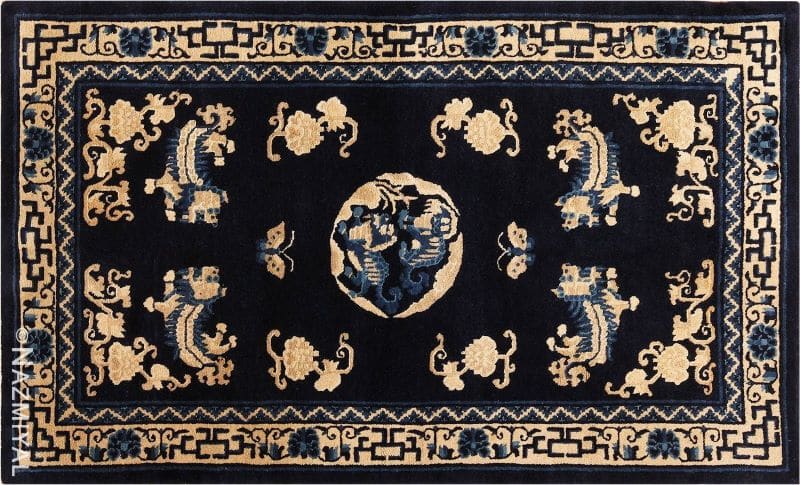
Small Antique Peking Foo Dog Chinese Rug
Aesthetic Considerations of the Foo Dog
The guardian lion pair should be placed according to tradition and the principles of Feng Shui. To ensure the favorable effects of the lions, they must be installed correctly.
- They must always be in a pair to ensure harmony.
- They need to be on pedestals or bases so as to improve their view of the spiritual terrain.
- They must be placed on either side of the entrance to keep it in the harmonious area between the two lions.
- The building must be at the backs of the lion pair so they can see the mischievous spirits approaching.
- They each have their own side in the pair to correspond to principles of Yin and Yang. When facing the entrance from the outside, the male goes on the outward, active side on the right. The female goes on the inward, steadying hand, the left side.
- If the lion pair is to be displayed inside, they must remain together, guarding the same room.
If the traditions for proper placement aren’t followed correctly, the house can become vulnerable to bad luck, dishonor or evil spirits.
Foo Dog Influence on Other Cultures
As might be expected, over hundreds of years of political and military domination, Imperial China had a profound impact on the cultures of surrounding civilizations from the central steppes of Asia to the eastern coast and the Southeast.
In addition, generations of Chinese people emigrating around the globe have brought their traditions along. The guardian lion is one of those traditions, often seen in the “Chinatown” areas of prominent American cities and in the other countries they made their new lives in.
China’s neighboring cultures have adopted or been influenced by many Chinese traditions. In Japan these guardian lions are named komainu, meaning “lion dogs.” The Japanese have a slightly different view of ki or chi and Buddhist principles of harmony than the Chinese. In that tradition, the male lion breathes inward to create life. The female breathes outward to represent female suffering and death.
Because of their original purpose in front of Buddhist temples, the lions spread to other temples in the region, including Tibet, Burma, Korea, Laos, Cambodia, Singapore, Vietnam and Thailand. Each culture has its own name for the stone lion.
With a rich, varied and ancient past, the Chinese lion keeps its traditional meanings and cultural importance intact. As decorative statuary, prized artwork or spiritual intercessor, they’ve traveled through time to the present age. Even in the 21st century they faithfully perform the solemn duty for which they were originally created.
This rug article about the Chinese Foo Dog motif was published by Nazmiyal Antique Rugs

